编译原理实验报告
姓名:布凡
学号:04070008
指导老师:蒋宗礼
完成日期:2007-6-19
�
实验一:词法分析
1. 实验目的
实现一个词法分析程序,将输入字符串流分解成终结符流供语法分析使用。
2. 实验内容
编制一个能够分析三种整数、三种浮点数、标识符、主要运算符和主要关键字的词法分
析程序。
3. 实验要求
编写能识别下列正规式的词法分析程序。
标识符 <字母>(<字母>|<数字字符 >)*(ε|_|.)(<字母>|<数字字符 >)*
十进制实数 (0|(1|2|3|4|5|6|7|8|9)(0|1|2|3|4|5|6|7|8|9) *).(0|1|2|3|4|5|6|7|8|9)(0|1|2|3|4|5|6|7|8|9) *
八进制实数 0(0|1|2|3|4|5|6|7)(0|1|2|3|4|5|6|7) * .(0|1|2|3|4|5|6|7)(0|1|2|3|4|5|6|7) *
十 六 进 制 实 数
0x(0|1|2|3|4|5|6|7|8|9|a|b|c|d|e|f)(0|1|2|3|4|5|6|7|8|9|a|b|c|d|e|f)
* .(0|1|2|3|4|5|6|7|8|9|a|b|c|d|e|f)(0|1|2|3|4|5|6|7|8|9|a|b|c|d|e|f) *
十进制整数 0 | (1|2|3|4|5|6|7|8|9)(0|1|2|3|4|5|6|7|8|9) *
八进制整数 0(0|1|2|3|4|5|6|7)(0|1|2|3|4|5|6|7) *
十六进制整数 0x(0|1|2|3|4|5|6|7|8|9|a|b|c|d|e|f)(0|1|2|3|4|5|6|7|8|9|a|b|c|d|e|f) *
运算符和分隔符 + - * / > < = ( ) ;{ } || && ! == #
关键字 if then else while do
4. 词法的状态转换图
ε
1---9
0---9
.
0---9
1
2
5
6
7
0---9
0---7
.
0
0---7
8
9
0---7
.
0---f
x
12
0---7
11
10
0---f
.
0---f
0---f
13
14
15
ε
ε
3
3
0---9| a---z | A---Z
0---9| a---z | A---Z
a---z | A---Z
.|_
a---z | A---Z|0--9
16
17
18
+ - * / > < = ( ) ; # || { } && == #
19
2
�
temp.code=28;
5. 词法分析的数据结构
typedef struct{
int code; //分析出的词元的编号
char value[VALUELEN];// 分析出的词元
的值(标识符或数值)
}Elem;
6.词法分析的算法
Elem Scan()
{
Elem temp;
int vlen=0;
GetBC();
if(curchar=='#')
{
temp.value[vlen++]='\0';
}
if(IsLetter(curchar))
{
while(IsLetter(curchar)||IsDigit(curchar))
{
}
while(IsLetter(curchar)||IsDigit(curchar))
if(curchar=='_'||curchar=='.')
{
Concat(temp.value,vlen);
{
Concat(temp.value,vlen);
GetChar();
}
Concat(temp.value,vlen);
GetChar();
return temp;
GetChar();
3
{
return temp;
temp.value[0]='\0';
if(curchar=='0')
{
if(temp.code!=0)
}
temp.value[vlen++]='\0';
temp.code=IsKeyWord(temp.value);
Retract();
}
else if(IsDigit(curchar))
{
Concat(temp.value,vlen);
GetChar();
if(!IsOctDigit(curchar)&&curchar!='.'&&curc
har!='x'&&curchar!='X')//int10 (0)
temp.code=2;
else if(curchar=='.')//real10 (0.)
Concat(temp.value,vlen);
GetChar();
{
while(IsDigit(curchar))
{
Concat(temp.value,vlen);
temp.code=5;
temp.value[vlen++]='\0';
temp.value[vlen++]='\0';
Retract();
return temp;
GetChar();
Retract();
return temp;
}
if(IsDigit(curchar))
}
{
�
{
}
{
}
else
{
if(IsHexDigit(curchar))
Concat(temp.value,vlen);
GetChar();
return temp;
Error(3);
temp.code=-1;
}
else
if(curchar=='x'||curchar=='X')//int16 real16
GetChar();
{
while(IsHexDigit(curchar))
Concat(temp.value,vlen);
temp.code=3;
temp.value[vlen++]='\0';
ToDecimal(temp.value,16);
Concat(temp.value,vlen);
GetChar();
if(IsHexDigit(curchar))
{
while(IsHexDigit(curchar))
{
if(curchar!='.')
{
Retract();
return temp;
}
}
4
}
}
return temp;
else
{
Retract();
}
else
{
GetChar();
return temp;
Concat(temp.value,vlen);
temp.code=6;
temp.value[vlen++]='\0';
ToDecimal(temp.value,1616);
}
Error(3);
temp.code=-1;
Error(4);
temp.code=-1;
}
else //int8 real8
while(IsOctDigit(curchar))
{
Concat(temp.value,vlen);
temp.code=1;
temp.value[vlen++]='\0';
GetChar();
return temp;
}
if(curchar!='.')
{
Retract();
}
{
�
}
Retract();
return temp;
}
GetChar();
GetChar();
if(IsOctDigit(curchar))
{
ToDecimal(temp.value,8);
Concat(temp.value,vlen);
while(IsOctDigit(curchar))
{
Concat(temp.value,vlen);
temp.code=4;
temp.value[vlen++]='\0';
ToDecimal(temp.value,88);
Error(3);
temp.code=-1;
while(IsDigit(curchar))
{
Concat(temp.value,vlen);
temp.code=2;
return temp;
}
else //int10 or real10
{
GetChar();
}
if(curchar!='.')
{
temp.value[vlen++]='\0';
}
else
{
return temp;
}
}
5
temp.value[vlen++]='\0';
Retract();
}
{
}
Retract();
return temp;
GetChar();
GetChar();
if(IsDigit(curchar))
{
return temp;
}
else
{
Concat(temp.value,vlen);
while(IsDigit(curchar))
Concat(temp.value,vlen);
temp.code=5;
Error(3);
temp.code=-1;
}
else if(curchar=='+')
{
temp.code=12;
}
else if(curchar=='-')
{
temp.code=13;
}
else if(curchar=='*')
{
temp.code=14;
temp.value[vlen++]='\0';
return temp;
temp.value[vlen++]='\0';
return temp;
return temp;
temp.value[vlen++]='\0';
}
}
�
temp.value[vlen++]='\0';
return temp;
temp.value[vlen++]='\0';
return temp;
temp.value[vlen++]='\0';
return temp;
return temp;
}
else if(curchar=='/')
{
temp.code=15;
}
else if(curchar=='>')
{
temp.code=16;
}
else if(curchar=='<')
{
temp.code=17;
}
else if(curchar=='=')
{
GetChar();
temp.code=27;
temp.code=18;
}
else if(curchar=='(')
{
temp.code=19;
}
else if(curchar==')')
{
temp.code=20;
return temp;
}
if(curchar=='=')
{
temp.value[vlen++]='\0';
Retract();
return temp;
temp.value[vlen++]='\0';
temp.value[vlen++]='\0';
return temp;
temp.value[vlen++]='\0';
return temp;
temp.value[vlen++]='\0';
return temp;
}
else if(curchar==';')
{
temp.code=21;
}
else if(curchar=='{')
{ temp.code=22;
temp.value[vlen++]='\0';
return temp; }
else if(curchar=='}')
{
temp.code=23;
}
else if(curchar=='|')
{
temp.code=-1;
return temp;}
temp.code=24;
}
else if(curchar=='&')
{
Error(1);
temp.code=-1;
temp.code=25;
}
GetChar();
if(curchar!='&')
{
temp.value[vlen++]='\0';
return temp;
temp.value[vlen++]='\0';
return temp;
GetChar();
if(curchar!='|')
{ Error(1);
temp.value[vlen++]='\0';
return temp;
return temp;
}
6
�
temp.value[vlen++]='\0';
return temp;
else if(curchar=='!')
{
temp.code=26;
}
else{ Error(0);
temp.code=-1;
return temp; }
}
5.测试用例和结果
测试用例
0 92+data> 0x3f 00 while a+acc>xx|| !(b
b then a=b else a=b-1+c; ==#
测试结果
INT10 0
INT10 92
+
IDN data
>
INT16 63
INT8 0
WHILE
IDN a
+
IDN acc
>
IDN xx
||
!
(
IDN b
<
IDN a
)
DO
IDN x
=
IDN x
-
INT10 1
;
IDN a
=
REAL10 6.2
+
IDN a
*
REAL16 136.500000
REAL8 28.312500
;
IF
IDN a
>
IDN b
THEN
IDN a
=
IDN b
ELSE
IDN a
=
IDN b
-
INT10 1
+
IDN c
;
==
7
� 实验二/三:语法制导的三地址代码生成程序
1. 实验目的
通过实现一个词法及语义分析程序掌握计算机语言的语法分析程序设计与属性文法应
用的实现方法。
2. 实验内容
编制一个 LR(1)自动生成程序,并用生成的 LR(1)分析表进行语法分析,生成三地址
代码。
3. 实验要求
1,自动生成 LR(1)分析表
2,采用 LR(1)分析法分析用类 c 语言文法编制的程序段。
3,从文件中读入源程序段。
4,根据下文中语法制导定义给出的属性文法生成三地址码。
4.文法的定义(消除二义性之后)
S'→ S #
S → U
S → M
U → while ( C ) S1
U → if ( C ) S1
U → if ( C ) M else U
M → if ( C ) M else M
M → id = E ;
M → {B}
B → S
B → S B
C → C || P
C → P
P → P && Q
P → Q
Q → ! Q
Q → ( C )
Q → E > E
Q → E < E
Q → E == E
E → E + T
E → E - T
E → T
T → F
8
�


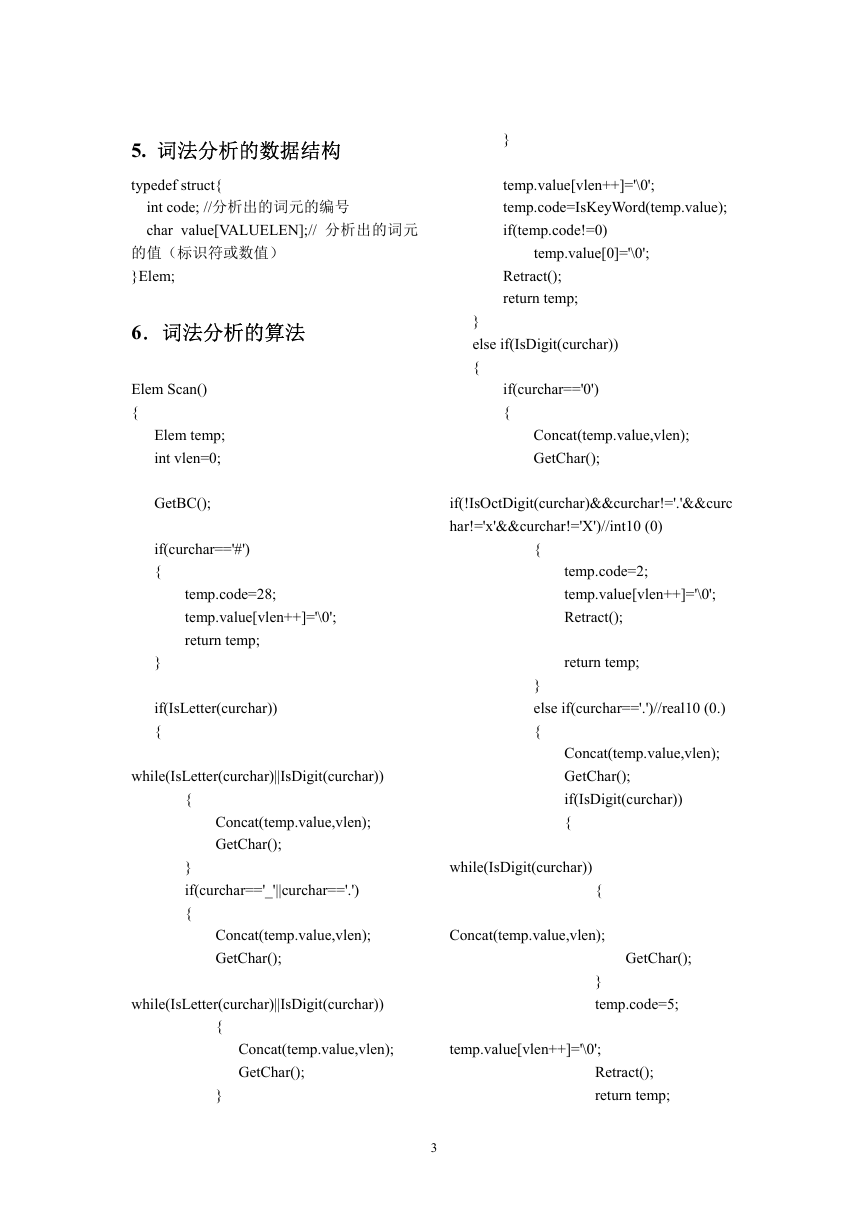
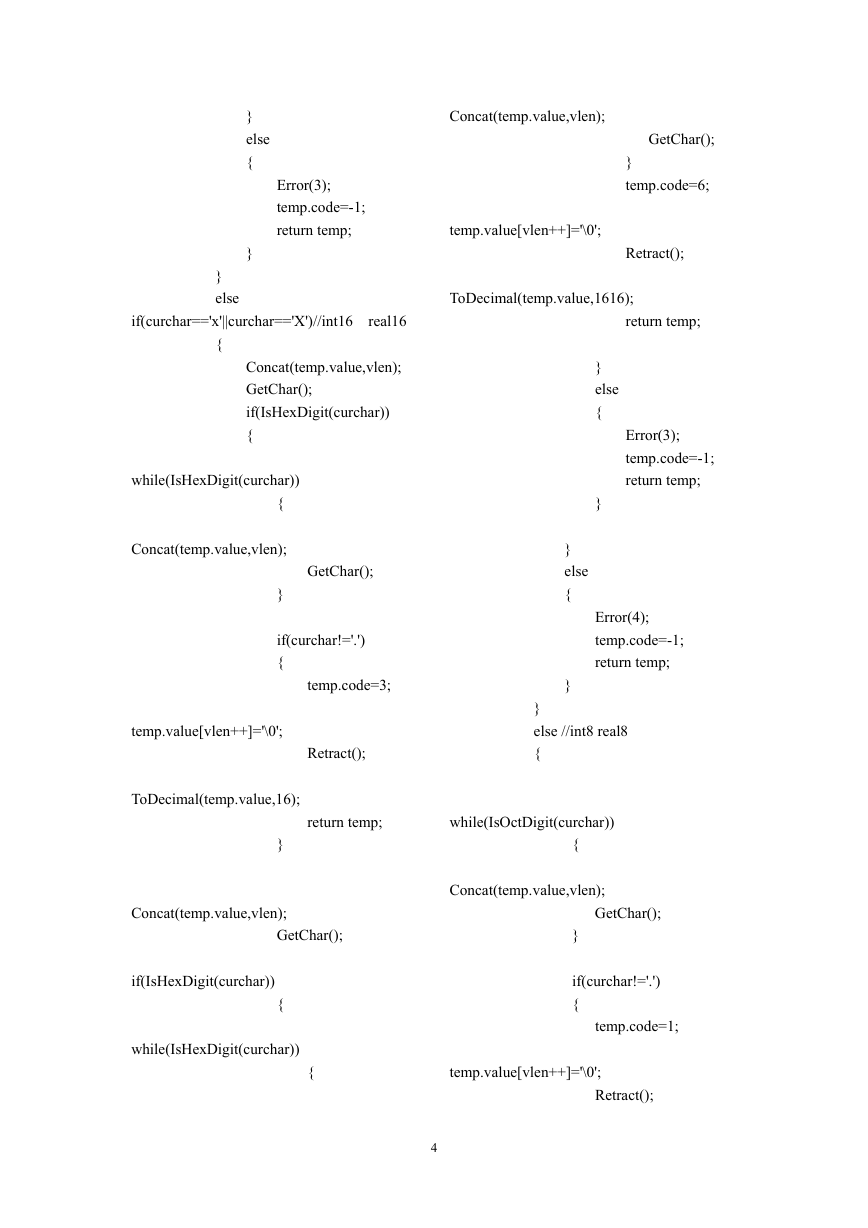
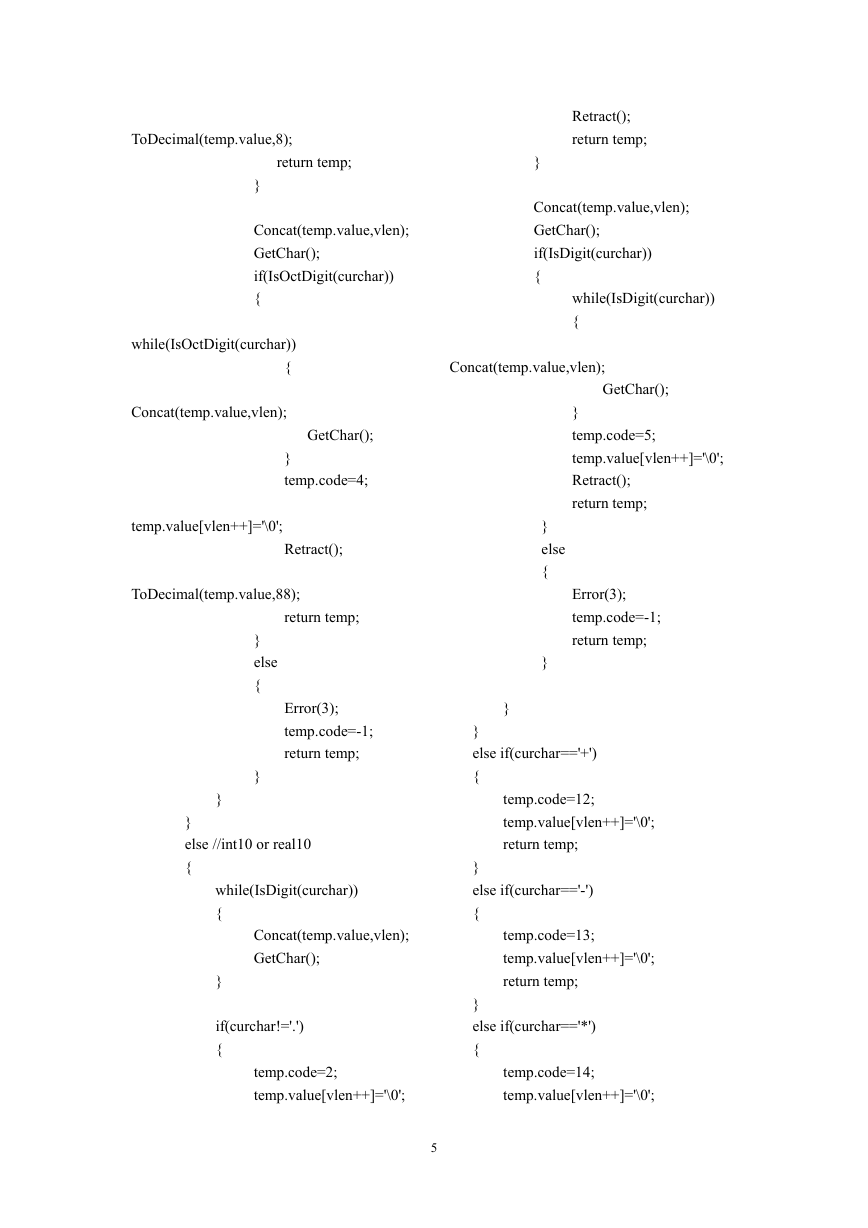
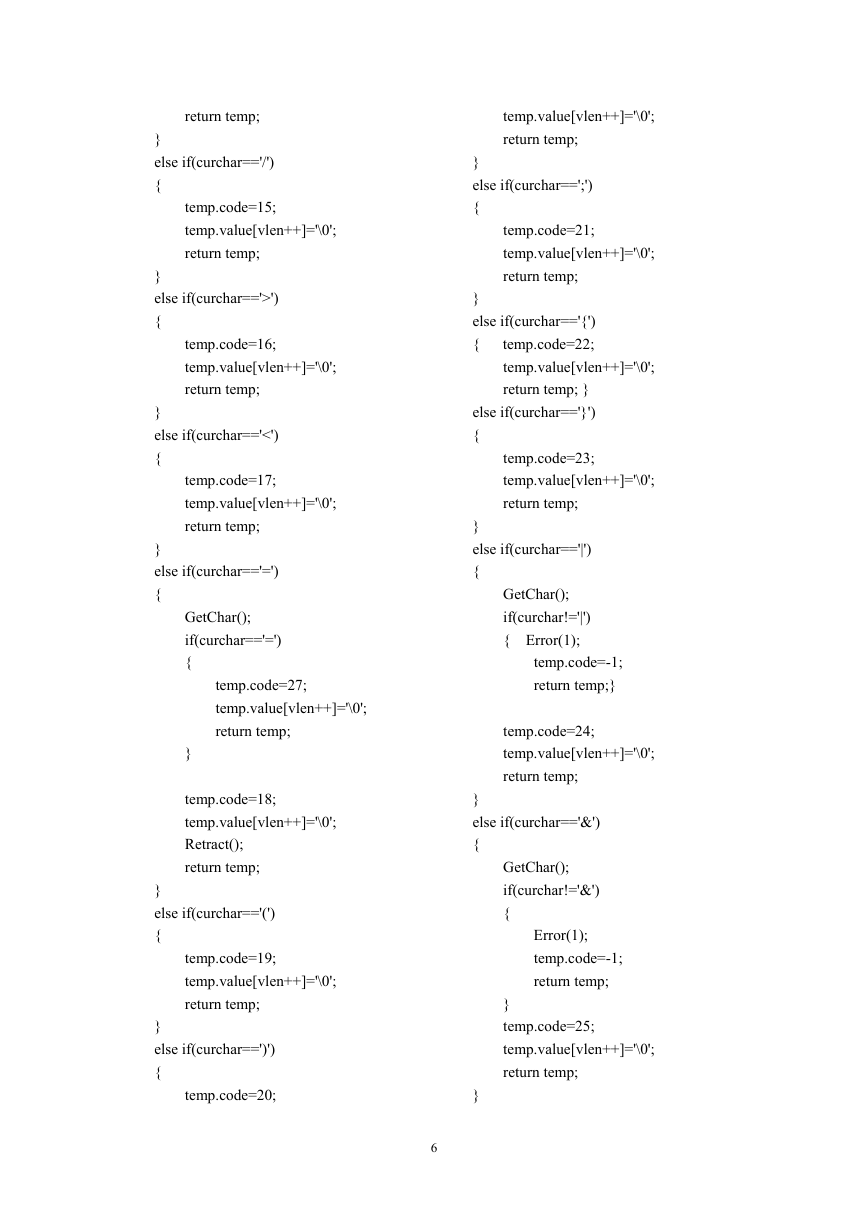
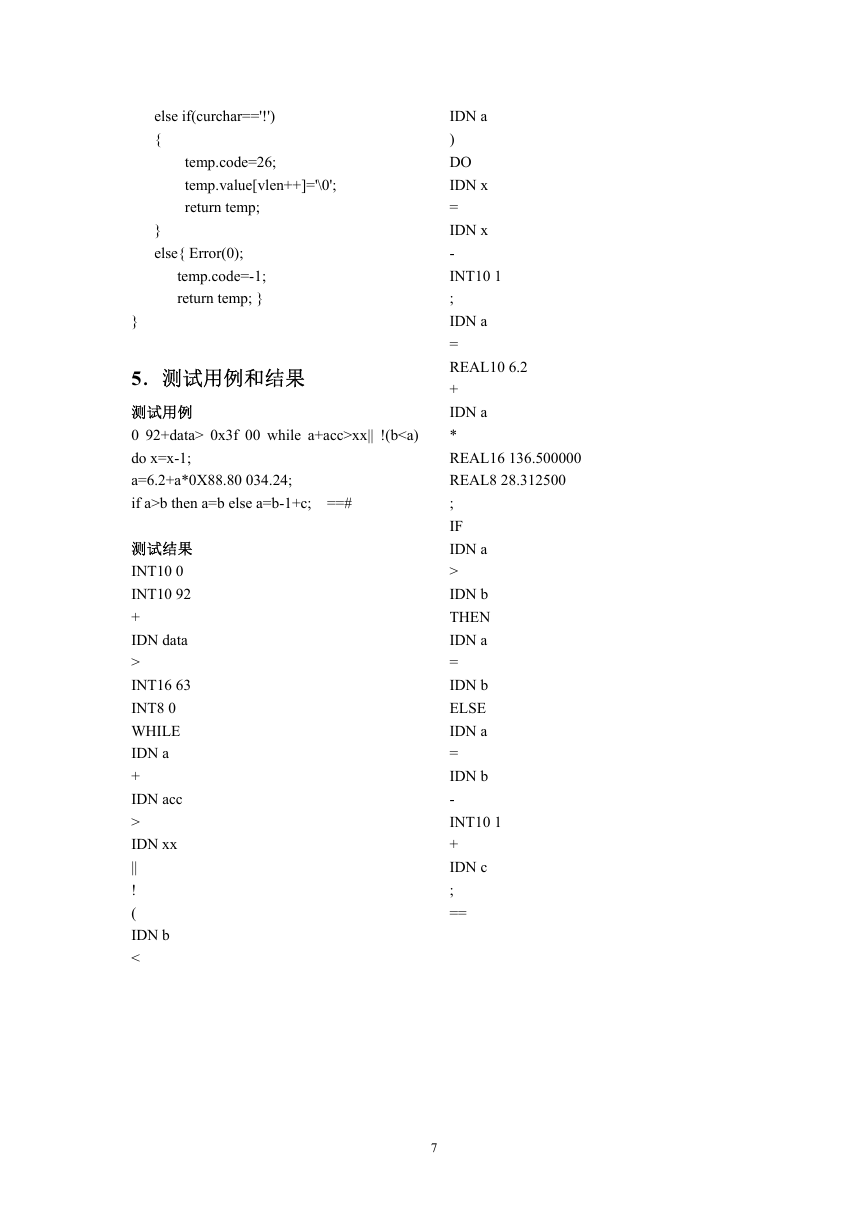
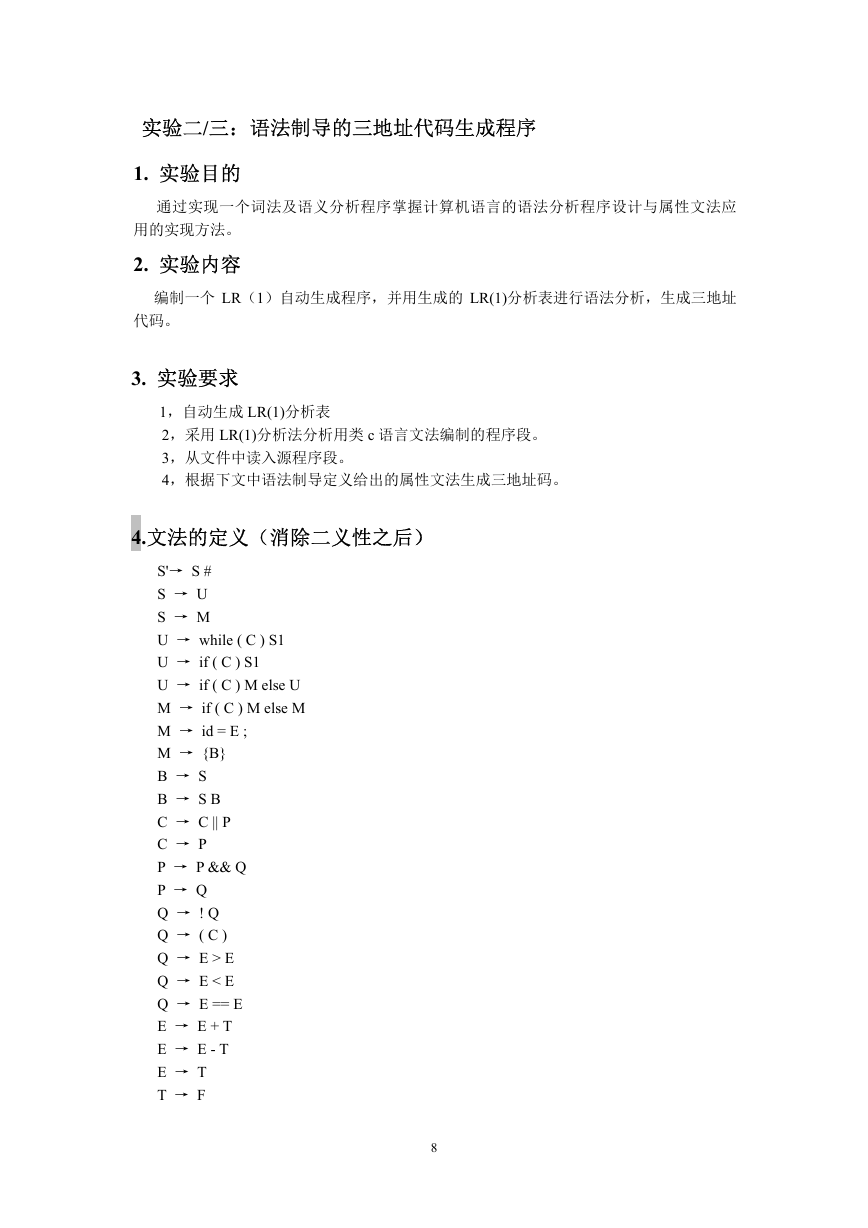








 2023年江西萍乡中考道德与法治真题及答案.doc
2023年江西萍乡中考道德与法治真题及答案.doc 2012年重庆南川中考生物真题及答案.doc
2012年重庆南川中考生物真题及答案.doc 2013年江西师范大学地理学综合及文艺理论基础考研真题.doc
2013年江西师范大学地理学综合及文艺理论基础考研真题.doc 2020年四川甘孜小升初语文真题及答案I卷.doc
2020年四川甘孜小升初语文真题及答案I卷.doc 2020年注册岩土工程师专业基础考试真题及答案.doc
2020年注册岩土工程师专业基础考试真题及答案.doc 2023-2024学年福建省厦门市九年级上学期数学月考试题及答案.doc
2023-2024学年福建省厦门市九年级上学期数学月考试题及答案.doc 2021-2022学年辽宁省沈阳市大东区九年级上学期语文期末试题及答案.doc
2021-2022学年辽宁省沈阳市大东区九年级上学期语文期末试题及答案.doc 2022-2023学年北京东城区初三第一学期物理期末试卷及答案.doc
2022-2023学年北京东城区初三第一学期物理期末试卷及答案.doc 2018上半年江西教师资格初中地理学科知识与教学能力真题及答案.doc
2018上半年江西教师资格初中地理学科知识与教学能力真题及答案.doc 2012年河北国家公务员申论考试真题及答案-省级.doc
2012年河北国家公务员申论考试真题及答案-省级.doc 2020-2021学年江苏省扬州市江都区邵樊片九年级上学期数学第一次质量检测试题及答案.doc
2020-2021学年江苏省扬州市江都区邵樊片九年级上学期数学第一次质量检测试题及答案.doc 2022下半年黑龙江教师资格证中学综合素质真题及答案.doc
2022下半年黑龙江教师资格证中学综合素质真题及答案.doc